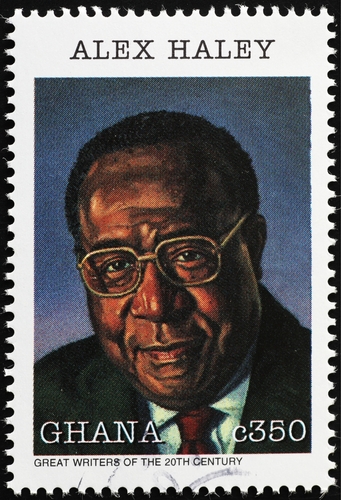Alex Haley, “Roots”, and DNA
In 1977 Alex Haley published the Pulitzer Prize winning novel “Roots”, one of the most consequential American epics of all time. The novel entertained millions and awakened a desire in many to search out their own family histories.
Haley claimed that Kunta Kinte, who was a real person, was his 4th great grandfather. Kunta Kinte was the main character in the book “Roots”. It was later determined that his original research was based on his misinterpretation of the oral history of the Kinte family. Disputes began to surface over the validity of Haley’s claim.
John Thornton, the director of Boston University’s African American studies program, found no relationship between Haley and Kinte. Thornton also served as the historical advisor of the “Roots” remake and wrote about Kunta Kinte’s life in Gambia and the town of Juffure.
Unfortunately, Haley died before the advancement of DNA and its implications to the study of genealogy. However, years after Haley’s death, in 2007, his paternal line nephew took a Y DNA test to validate his and his uncle’s patrilineal ancestry and the history of Haley’s great grandfather.
Family lore suggested their female slave ancestor had been raped by the overseer on the Haley plantation in Marion County, Alabama. The name of the overseer was Baugh. Chris Haley’s Y DNA match was a man from Scotland named Baff, a derivation of Baugh. Haley once stated, “My father’s father well knew that his father was an overseer, a frequent rapist of slave women – Jim Baugh.”
Following the Civil War, slaves were emancipated. They needed to take a surname and it was customary for them to take the surname of their owner. Alex Haley’s post war ancestors followed this tradition and took the name of their plantation owner named Haley.
Now, the Y DNA tests have established that Haley, whose monumental work is credited with helping transform the self-awareness of millions of black Americans, is directly descended from the Baugh/Baff family of 17th century Scotland.
Y DNA Testing for Genealogy Purposes
One thing you will NOT discover with a Y DNA test is that men are from Mars and women are from Venus. Although sometimes is seems that way. You WILL discover that Y-DNA can be traced far back into the past and that every male can trace their Y-DNA back tens of thousands of years to a single man, Y – chromosomal Adam, from whom all currently living humans are descended.
But it only traces back the paternal line starting with your father and his brothers, your grandfather, and his brothers and on back through time. Basically speaking, females do NOT carry the Y Gene.
If you were to take a Y DNA test or in case you are a female and have a brother, father, uncle take the test you will receive results placing your male line in a haplogroup or ethnic group. Each haplogroup is associated with ancestral groups such as the Vikings, Celts, or Native Americans. If you are black from an uninterrupted family history, your results will come back African. For most people of European descent, the haplogroup is R1b. Be aware, this is a very simplified definition of haplogroup divisions.

This advance of Y DNA testing has provided genealogists with an extremely valuable tool in their arsenal. Y DNA, or male line testing, is tremendously helpful for surname research where matches between two men of the same surname can indicate a common male ancestor or a completely different haplogroup.
Here is where it gets a little dicey. There can be a couple of reasons why two men with the same surname come from different haplogroups. Let’s say genealogy research has shown two Copeland men sharing the same ancestry, but the test results are diverse. One of the men’s haplogroup results are R1b and the other haplogroup R1a. The first thing that is obvious is that they do not share a common ancestor.
One reason for this anomaly is that a non-paternity event occurred that was unknown to modern day researchers. Perhaps there was a young orphan boy by the name of Smith. His parents died out on the American frontier and this youngster was taken in by a neighbor with a different surname. The child eventually adopted his new family’s surname, and the adoption was forgotten about in future generations. Another NPE occurred when a woman had a relationship with someone other than her husband, but the child was raised by the husband and the child took the husband’s name.
The Author, a female, had a male cousin test his Y DNA
Being a female, I could not have my own DNA tested to find out about my father’s male line Haplogroup. My father and his one brother have both passed so at my request, my Copeland uncle’s son Jeff agreed to have his Y DNA tested with the Copeland Surname Project. Jeff and I share a Copeland grandfather whose genealogy we are putting forth in the project.
The Copeland Project
By placing Jeff’s test results with the Copeland project, we expected to see common relationships with those that share his haplogroup or haplotype. First, Jeff’s test results placed him in Group 1. The Haplogroup assignment for group 1 is R1a1a1a, later tagged M417.

What exactly does this mean?? Jeff’s test results show our Copelands stem from Norse Vikings who traded, raided, and finally settled in the British Isles. This is the haplogroup that at one
time would have earned you a “Viking” certificate from Oxford Ancestors, a commercial genetic genealogy company launched in April 2000 by the late Professor Bryan Sykes, a Professor of Human Genetics at the University of Oxford in England. Unfortunately, the certificate is no longer offered.
M 198/M417 along with Q, are the only haplogroups that can emphatically be linked to Norse ancestry, and more specifically to the west coast of Norway. This occurs at a relatively high frequency in the Scandinavian countries at over 30%, in Norway, 20% in Sweden, and 15% in Denmark.
Many of the Border Reiver families have Viking origins and Cumbria, a county in England, offers abundant evidence of Viking settlements. The region of Copeland, in Cumbria, is situated along the coast exactly where the Norse Copelands entered England at the time of the first millennium. Our haplogroup is most highly concentrated in this northwestern part of England.
So, do we know of any Vikings in our family tree? Of course not! Parish registers, in the British Isles, did not begin until 1538. Even from this date they are rarely preserved. It was well before the first millennium when the Vikings raided (among other unmentionable things) up and down the Irish Sea. They invaded Ireland in 794 AD and the Irish began kicking them out around the first millennium. At this point the Norse that were kicked out of Ireland, found new homes up and down the Irish Sea where their compatriots had previously settled.
Vikings in Scotland, the Isle of Man, and Ireland, Our Copeland Ancestors
Approximately 870 AD the Norse Vikings took over and settled Iceland, the Faroes, and Orkney. They eventually became farmers and fishermen. Orkney became a power center, and from there the Earls of Orkney ruled most of Scotland. To this day, especially on the north-east coast, many Scots still bear Viking names. One of our closest Copeland Y DNA matches, resides in the Orkney Islands.

These Scandinavian-held territories included not only the Isles of Orkney, but the Shetland Isles, the Hebrides, the islands of the Firth of Clyde and mainland territories including Caithness and Sutherland. Genetic studies show deep Norwegian lineage in people of northern Scotland. A team of researchers from Scotland and the U.K. has found via genetic study that many people in modern Scotland are of Norwegian descent.
Very little written history exists except for the Irish annals and the later Norse sagas of which the Orkneyinga saga is the principal source of information. However modern archaeology is beginning to provide a broader picture of life during this period. The Isle of Man became a Viking kingdom. In Ireland, the Vikings raided around the coasts and up the rivers. They founded the cities of Dublin, Cork, and Limerick as Viking strongholds. The Danes, also Vikings, although of a different haplogroup, took over Northumbria, East Anglia, and parts of Mercia. In 866 they captured modern York (Viking name: Jorvik) and made it their capital. They continued to press south and west. The kings of Mercia and Wessex resisted as best they could, but with little success until the time of Alfred of Wessex, the only king of England to be called ‘the Great’.
The Copeland Y DNA Family Tree Project
To this date there are 124 members of the Copeland Family Tree Y DNA Project. These 124 test results were separated into 12 different groups, each group representing families that came from the same common ancestor, different haplogroups. The results of the male Copeland who tested his Y DNA for our branch of Copeland family and the author’s first cousin), tested into Group 1 of the project. The next blog will pick up where I have left off, by explaining the different groups and what that means for our future Copeland genealogical research.
Subscribe to my newsletter on the right side of this post for my future blog post or posts with more information on what we have learned about our Copeland families and their diverse ethnic backgrounds discovered through DNA.


0 Comments